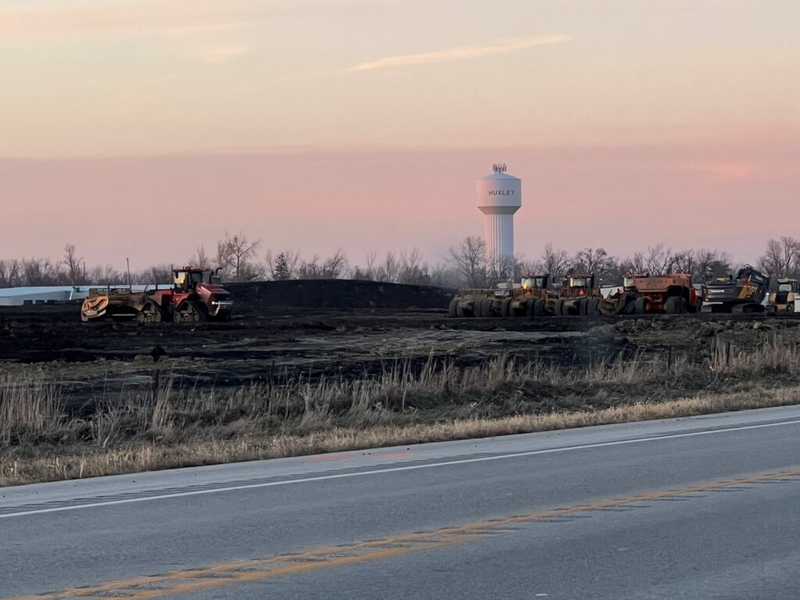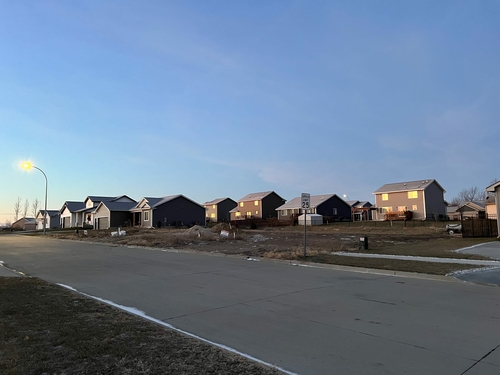There goes another perfectly good cornfield


As I drove back home later that evening, I craned my neck to see what was happening. Sure enough, I could tell the entire field was being cleared right by our expanding Huxley Development Park. I asked around and learned that yet another new housing development was underway.
I grew up in Huxley, left the state for several decades and ended up back in my hometown a bit by accident. When I was a kid, the population was around 500. Today, our town has over 4,000 people. Sandwiched between Ames and Ankeny and within driving distance of Des Moines, Huxley offers affordable housing and a good school district, so we are growing rapidly.
As I wrote in my very first Dispatches from the Heartland column, “Walking and watching in the heart of Iowa,” new housing developments have sprung up on every side of town. There are recently built neighborhoods on the north side by Deer Creek, a wooded community that was built back in the 1980s. There are single-family houses and some ponds to the west by the high school, close to another development that was built in the early 2000s on land where fields once stood.

Then there’s the east side: on our morning walks, my dog Tango and I monitor the new houses going up over there, since that’s our standard route. These mid-priced lots used to be farmland, and the backyards butt up against fields still in operation; some years they’re planted in corn, some years in beans.
Over the last year – a corn rotation – we’ve had a front row seat as at least 20 houses have been constructed practically before our eyes. I’m pretty sure I could frame a house myself just from observing the day-to-day progress. It’s fascinating. We’ve watched the new families moving in, mostly young couples with kids and dogs, all against the backdrop of planting, knee-high corn in July, and the harvest.
Now, expansion is happening to the south, past the Development Park, which includes our UnityPoint Clinic Family Medicine, the Hy-Vee pharmacy, Bud’s Auto, and other establishments needed to serve our burgeoning population.
Our little town is on the move. We’re lucky in that regard; many small Iowa towns are dying. Our population and industry is expanding. I am a big proponent of affordable housing and a champion for economic development, so part of me is ecstatic to see this growth. But the farmland around us is receding and the farm kid in me chokes up every time I see a beautiful meadow being plowed up or precious topsoil being excavated. Because – like they say about real estate in Manhattan – they’re not making any more of it.

The amount of farmland in operation all across Iowa is steadily shrinking. According to the USDA, National Agricultural Statistics Service – Farms and Land in Farms 2021 Summary Report released in February of this year, the total number of farms in Iowa in 2021 was 84,900, down 100 farms from 2020. Total land in farms for Iowa during 2021 was 30.5 million acres, and the size of the average farm was 359 acres, down 1 acre from 2020.
That same report indicates the decline in farms and farmland is happening nationwide. In the U.S., the number of farms in 2021 was estimated to be 2,012,050, down 6,950 farms from 2020. Total land in farms was estimated to be 895.3 million acres, which is down year over year by 1.3 million acres.
I wondered how the number of farms and acres had changed during my lifetime. Upon some investigation, the results were as alarming as I assumed they would be. A report from the USDA, NASS 2012 Census of Agriculture, which also references earlier census data, shows that in 1982 there were 2.48 million farms in the U.S. By 2012, that number had decreased to 2.11 million farms representing 914.5 million acres. Since the time I graduated from high school, 467,950 farms have disappeared from the U.S. That’s nearly a half million farms gone or consolidated, and more acres are taken out of production every year.
Scores of ag economists can tell us what that means to our overall agricultural economy nationwide and here in Iowa, but the bottom line is that exponentially fewer farms means major disruption to that industry over time. Ecologically, the implications of lost topsoil are also devastating. A recent Smithsonian magazine article estimates that in the Corn Belt, about 35% of the region’s topsoil is completely gone, “leaving carbon-poor lower soil layers to do the work of supporting crops.”
Much of that loss can be attributed to soil erosion, but the overall estimated cost to the Midwest’s agricultural industry is almost $3 billion annually. If we’re losing topsoil because we’re digging it up intentionally, that just compounds the long-term economic and ecological issues.
The number of farms and acres in production have gone down, but the prices are going up, up, up – and up some more. In the early 1980s, Iowa farmland sold for an average of $2,147 per acre, according to the Iowa State University 2021 Farmland Value Survey. That survey showed that two years ago, quality farmland in Iowa sold for an average of $$9,751. Fast forward to this year; according to data from the Federal Reserve Bank of Chicago and numerous media reports, sections of farmland have sold for as much as $19,600 per acre and farms in the state have sold for as high as $25,500 an acre.
When my family and I heard that $19,000-plus per acre number, we about fell over. Many news-reading or agriculture-following Iowans are well aware of these escalating land prices, but younger citizens or folks outside our region don’t necessarily know or have any context about what it means.
Why is the land for sale and who is buying it? The 2021 Farmland Value Survey Iowa State University says, “The majority of farmland sales, 68%, were to existing farmers, of which existing local farmers captured 66% of land sales. Only 2% of sales were to existing, relocating farmers. Investors represented 25% of land sales. New farmers represented 4% of sales, and other purchasers were 2% of sales.” That report indicates that 54% of farmland sales were from estate sales, closely followed by sales by retired farmers, which accounted for 24%. Active farmers represented 9% of sales and investors accounted for 10%.
In other words, farmers are passing away or retiring and land is changing hands. That is not new, but it is accelerating. If you look at the skyrocketing price of farmland, it’s easy to see why heirs, in state or out of state, or retiring farmers are selling their farms. No matter how much you love the old meadow or the view of the sun setting over the cornfield, there are choices to make. There’s labor to consider and money on the table.
So land is for sale. Young folks need starter houses. Older folks need places to live as well; apparently the new development here on the south side of Huxley will include much needed retirement housing. When more people come to town, we need new business and construction begins. If we’re going to expand, the options are to rebuild existing neighborhoods or spread out into the surrounding farmland. And that’s how perfectly good cornfields get plowed under.
I understand the economics that are driving these changes. I’m also happy that my tiny town is growing and transforming. But I remember when the landscape was just farmland as far as the eye could see — the vast fields, the views uninterrupted save for a water tower or grain co-op, the pride in Iowa’s agricultural heritage and economy.
I mist up little when I drive past the development that stands where my favorite rolling sheep meadow used to be. It was so lovely. Where there is a block of houses with gazebos and pools, I can visualize the gently sloping green pasture where cattle once grazed. I can hear my grandmother and mother’s voices talking about being stewards of the land, pronouncing the word “soil” with reverence. I wonder what I’d do if I had farmland for sale.
There are always tradeoffs to moving forward. This was prairie before it was fields, after all. When we plow under our precious topsoil and uproot our cornfields, we have to ask: What is the price of this particular progress? That’s what Tango and I ponder on our morning walks, as we see the brilliant sun rising behind the new houses over on the east side of town, frost shining on the cornfields behind them.

This column was originally published by Suzanna de Baca’s blog, Dispatches from the Heartland. It is republished here through the Iowa Writers’ Collaborative.
Editor’s note: Please consider subscribing to the collaborative and the authors’ blogs to support their work.








